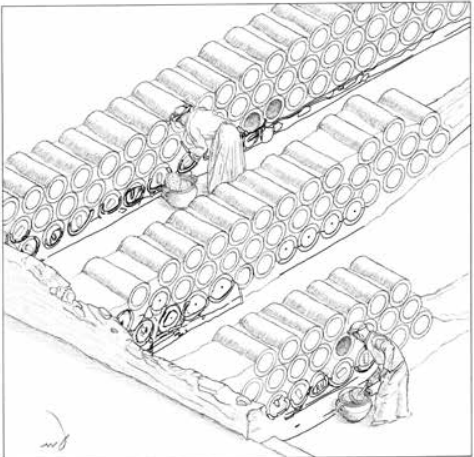The Ceramic Beehives in the Ancient Times
- CERAMIC BEEHIVES

- 20.01.2021 г.
- време за четене: 2 мин.
Актуализирано: 2.12.2021 г.
In this article, we would like to elaborate more on the historical proves of the use of ceramic beehives.
Did you know that ceramic beehives were widely used in the beekeeping in Ancient Greece, the lands of Israel, Egypt, Turkey, Morocco, Jordan, Syria, Lebanon, Iraq, Iran, the Arabian Peninsula?
Of course, their type was far different from what is common now to be used in the apiculture - there were mainly cylindric and there were two popular ways of utilizing them - vertical and horizontal.

Evidence for them are found in numerous archeologic excavations in the Aegean region - from archeological sites and ancient scratches.
Beekeeping has been flourishing thousands years AD and obviously the ceramic beehives were able to provide the beekeepers with good production.
For unknown reasons ceramic stopped being used in beekeeping.
Some researchers supposed that it was because of temperature disadvantages of the ceramic hives BUT recent studies reject this hypothesis.
Katerina Kalogirou (Aristotle University of Thessaloniki) and Alexandos Papchristoforou (Aristotle University of Thessaloniki & Cyprus University of Technology) designed an experiment in which they constructed two copies of ancient Greek beehives and compared the homeostasis in them with the indicators for it in a standard Langstroth Ruth hive.
"The results obtained by this study, clearly showed that the ancient Greek clay beehives offered ideal conditions for the development of honey bee colonies. Homeostasis, in terms of temperature variation, was normal and optimum for the rearing of brood and the functioning of adult population. Colonies established in clay colonies presented no adverse behavioural or biological effects. Strength of colonies (in terms of adult population and brood area) as well as wintering procedures was normal and colonies survived for two continues years before re-established in Langstroth beehives for commercial manipulation."
It is not the only evidence. A study by J.E.Francis published in the Oxford Journal of Archeology also brings insights about similar tests proving that the temperature in the ceramic beehives in the summer and winter periods is "within the norms".
All these experiments are run with copies of the ancient ceramic beehives and we are now enojoying the fruits of the industrial advancements. Can you imagine how productive these ancient hives would be if they were upright boxes? Now they are!
Taking the culture and knowledge from our ancestors, fusing it with the modern streams in beekeeping, we worked a lot to improve the clay recepies and increase even more the insulation properties. Today we are able to present to you a natural product which can provide your bees with a safe and stable environment to keep them happy and motivate them to produce more honey and bee products.
Read more about our studies and experiments in the R&D section of our website.
Don't miss to check also our store, where you can find more pictures and detailed description of the hives available today.

* For this article was used information and pictures published in the book of the International Syposium "Beekeeping in Meditarranean from Antiquity to Present", 09-11 October 2014, Syros, (ed. by Fani Hatjina, Georgios Mavrofridis, Richard Jones)








Коментари